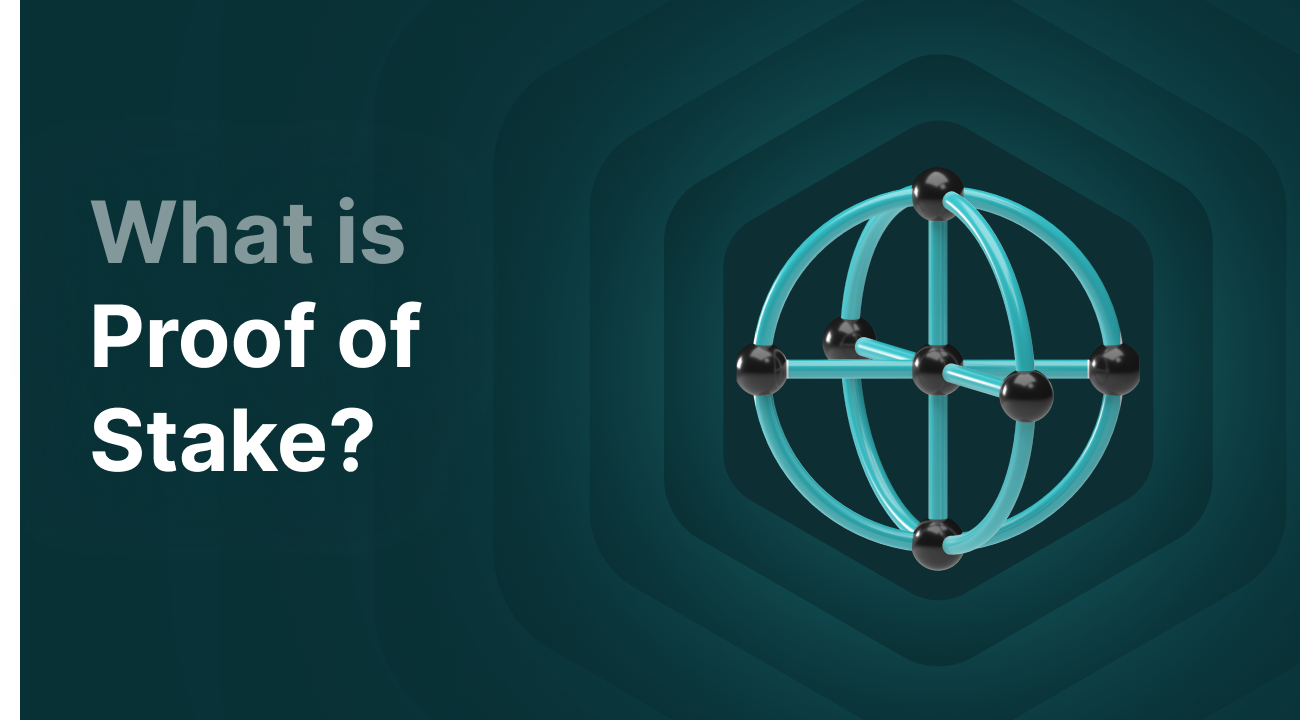What is Proof of Stake and How Does It Work?

What is Proof of Stake?
Proof of Stake (PoS) is a consensus mechanism used by blockchains to validate transactions and add new blocks through staking crypto. This process is called staking and is more energy-efficient than Proof of Work (PoW), the consensus mechanism of Bitcoin. PoW is energy-intensive because computers work around the clock to solve complex mathematical equations. With PoS, users can stake cryptocurrency on the network via nodes. This allows transactions to be processed without the need for powerful computers. The more nodes there are, the more decentralized the network becomes (provided the nodes are not owned by the same entity).
Key Takeaways
- Proof of Stake (PoS) is an energy-efficient consensus mechanism that validates blocks based on staking cryptocurrency.
- PoS doesn’t require powerful computers but uses staking to validate transactions, add new blocks to the blockchain, and secure the network.
- Small users can delegate tokens to validators via staking pools to earn rewards.
- There are multiple PoS variants, such as Delegated PoS, Bonded PoS, Pure PoS, and hybrid forms.
- Major blockchains like Ethereum, Cardano, Solana, Cosmos, and Algorand use PoS or a variant of it.
- Benefits of PoS include energy efficiency, scalability, and accessibility.
How Does Proof of Stake Work?
Proof of Stake works with nodes and validators. A validator is a node that actively participates in validating transactions and proposing new blocks. Not every node is a validator. There are also nodes that support the blockchain without validating transactions. Validators are randomly selected based on the number of tokens they stake: the more tokens, the greater the chance to validate a block. Anyone can participate in staking, but some blockchains require a minimum amount of tokens to become a validator.
Here’s how it works: a validator is selected by other nodes to add a block. Before this happens, the validator must validate and process all transactions. After that, a new block can be created and added to the blockchain. The validator is rewarded with new tokens as a thank-you for helping to secure the blockchain and verify transactions.
Security of Proof of Stake
Nodes play a crucial role in securing the network. They check whether validators perform their tasks correctly and are not trying to manipulate the network. If there is suspicion of a malicious validator attempting to manipulate the system, a vote can be held. If 51% of the nodes find the validator guilty, the network removes them. There are often additional penalties. These vary per blockchain but usually involve a total or partial loss of the staked tokens.
This is also why a node with a high stake has a better chance of validating a block, as a higher stake indicates the node is taking on more risk and thus wants to act honestly. Critics argue that this compromises network decentralization because large validators are more likely to add blocks and earn rewards. Additionally, larger validators have more influence in key network votes.
Staking as a Small Participant
As a small participant, setting up your own validator node can be challenging. You face fierce competition from nodes with much more capacity. The chance to validate a new block is minimal. Additionally, technical expertise is required. That’s why it’s also possible to lend (delegate) your tokens to other validators.
On many blockchains, you can delegate tokens to existing validators via a staking pool. You retain ownership of your tokens, but by delegating them, you increase the validator’s stake, boosting their chances of block validation. In return, you receive a share of the rewards earned by the validator.
Delegating tokens is not entirely risk-free. You are essentially lending your tokens to a validator. If this validator turns out to be malicious, they can be penalized by other nodes. Your tokens may be at risk since you entrusted them to the validator.
Therefore, always do thorough research before deciding to delegate your tokens to another validator. Things to consider include:
- Investigate the staking pool's reputation within the community.
- Check the validator's uptime (is the node consistently up and running?).
- Has the validator made technical errors in the past and received penalties?
- What fee does the validator pay out (note: a high fee doesn’t necessarily mean high reliability)?
- How many delegators are there, and what is the total stake (a high stake and many delegators can indicate reliability and decentralization)?
Which Blockchains Use the Proof of Stake Algorithm?
Proof of Stake is a highly popular consensus mechanism because it’s far more energy-efficient and scalable than Proof of Work. Many major blockchains therefore use this technology. Below are the biggest cryptocurrencies using Proof of Stake (PoS):
Ethereum
The most well-known example is Ethereum. In its early years, the network used Proof of Work but later transitioned to Proof of Stake. During the famous upgrade to Ethereum 2.0 (a series of major updates), Ethereum transitioned to Proof of Stake following the ‘The Merge’ update in 2022.
The reason for the switch: scalability issues resulting in high transaction fees for users (sometimes hundreds of dollars) and low transaction speeds.
Cardano
Cardano uses a Proof of Stake-based consensus algorithm called Ouroboros. Charles Hoskinson and his team felt it necessary to implement modifications to Proof of Stake to ensure better security.
Solana
Solana combines Proof of Stake with a self-developed consensus mechanism called Proof of History (PoH). Solana is known for its tremendous speed, low costs, and high scalability.
Cosmos
Cosmos uses a version called Tendermint PoS. It's a consensus mechanism that combines the classic PoS model with Byzantine Fault Tolerance (BFT), offering a solution to the Byzantine Generals Problem. This approach is known for being fast, secure, and relatively scalable. Cosmos focuses on interoperability and acts as a bridge between different networks.
Algorand
Algorand uses Pure Proof of Stake and randomly selects validators to validate a block, which benefits decentralization. The network is fast and can process up to 1,000 transactions per second.
What Are Other Forms of Proof of Stake?
In the meantime, many variants of Proof of Stake have been developed. Each has its own features and benefits. Below are the most well-known types explained:
Delegated Proof of Stake (DPoS)
With DPoS, the network selects a set number of validators who can add blocks through voting. This makes the system highly scalable. Voters receive a share of the rewards validators earn for validating transactions. The downside of DPoS is that it’s much more centralized than other Proof of Stake mechanisms, as the same validators consistently hold power.
Example: Tron
Bonded Proof of Stake
In this system, you lock your tokens for a certain period. This is called bonding. By staking through bonding, you help validate transactions and earn rewards. Additionally, it gives you voting rights for important updates. The more tokens you stake, the more voting power you get. The downside is that you can’t easily withdraw your tokens, making it hard to sell during significant price drops.
Example: Cosmos
Pure Proof of Stake
This form aims to be very decentralized and fair. Validators are randomly and anonymously selected. This means everyone has a chance to validate transactions and earn rewards. Still, the more tokens you hold, the higher your chance of verifying a block.
Example: Algorand
Nominated Proof of Stake (NPoS)
Polkadot uses NPoS, a system where nominators select suitable validators. Nominators essentially assign their staked tokens to a validator. The more support a validator receives, the higher their chance of validating a block.
Example: Polkadot
Effective Proof of Stake
In this form, the longest-active stakers receive the most rewards. The longer you actively participate, the higher your rewards. This makes it economically attractive to stay active.
Example: Harmony
Anonymous Proof of Stake
With Anonymous Proof of Stake, the identity of stakers is anonymous. It combines privacy with PoS. The entire process is anonymous: from validation, adding new blocks, to distributing rewards.
Example: PIVX
Leased Proof of Stake
This form allows users to directly lease their tokens to validators to contribute and earn staking rewards. Validators bundle the leased tokens and use them to add new blocks. Uniquely, the validator has control and can set conditions. On the other hand, leasers can easily switch if the validator sets unreasonable demands.
Example: Waves
Hybrid Proof of Stake
Hybrid Proof of Stake combines PoS with PoW. The system does this to blend the security of Proof of Work with the scalability of Proof of Stake. The system often uses PoW for block production and PoS for validation.
Example: DASH
Secure Proof of Stake
This form is used by Elrond and selects validators based on reputation and stake. Each staker receives a score that changes based on their behavior. This makes the system transparent. Misbehavior gives you a bad reputation and reduces your chance to validate transactions. Any manipulation is strictly punished.
Example: Elrond
Thresholded Proof of Stake
This system is used by NEAR Protocol and only distributes rewards once a threshold is reached. The threshold depends on network activity and stake.
Example: NEAR
Pros and Cons of Proof of Stake
Proof of Stake vs Proof of Work
Final thoughts
Proof of Stake offers an efficient and sustainable alternative to traditional Proof of Work systems. While there is a risk of centralization and tokens can sometimes be temporarily locked, it provides broad participation opportunities and is accessible. Additionally, PoS is highly scalable and can process transactions at high speed. Due to its many variants and applications, PoS has become a key foundation in the world of blockchain technology.




